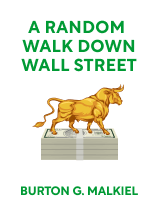

This article is an excerpt from the Shortform book guide to "A Random Walk Down Wall Street" by Burton G. Malkiel. Shortform has the world's best summaries and analyses of books you should be reading.
Like this article? Sign up for a free trial here .
Are you looking for a guide to investing by age? How should your investing strategy change as you age?
Age may just be a number, but it’s vitally important when deciding how to allocate your investments. For example, someone in their twenties will have completely different priorities and considerations than someone who is retired. As such, it’s important to consider investing by age recommendations.
Keep reading for our complete guide to investing by age.
A Guide to Investing by Age
Age is an important factor when creating your investing strategy. For example, a fully employed 30-year-old, with many years of labor income ahead of her, can weather more losses (and thus tolerate more risk) than a retired 70-year-old who relies on his investment income to get by.
Our complete guide to investing by age will help you make the right choices with your investments.
In terms of investing by age, economist Burton Malkiel offers the following advice: The longer you’re able to hold on to your investments, the more common stock you should have in your portfolio. If you have many years of working ahead of you, your allocation should be mostly stocks; if your working years are winding down, you should have a heavier share of bonds. This is the key to investing by age.
Five Allocation Principles
These five key principles will help you navigate investing by age and make the right choices:
1) Risk and Reward Are Two Sides of the Same Coin
Historical returns have shown conclusively that assets with higher volatility hold the potential for higher returns.
For example, between 1926 and 2017, small-company common stocks, which had the highest volatility of the standard investment instruments, also boasted the highest average annual return. Stocks have provided an average compounded rate of return of over 8% since 1790, but they’ve also posted negative returns in three out of every 10 years, on average.
2) Actual Investment Risk Is a Function of Time
Although certain assets are inherently riskier than others—for example, stocks as an asset class are generally riskier than bonds—those risks can increase or decrease depending on how long you hold the asset.
For example, between 1950 and 2017, the range of returns on common stocks held for just one year was +52.6% to -37%, whereas common stocks held for 25 years had a range of +17.9 to +5.9%.
Bonds, too, mellow with age. If you’re able to hold a bond until maturity, you should see a return at or near the initial yield. If you have to sell the bond a year after you’ve purchased it, though, you might see a null or negative return.
As noted above, the longer you can hold onto your investments—that is, if you’re currently earning a wage and have no need to sell assets to maintain your quality of life—the more common stock you should have in your portfolio. If you’re past working age and need a reliable stream of income from your investments, a higher concentration of bonds is the more prudent choice.
3) Reduce Risk Further With Dollar-Cost Averaging
Dollar-cost averaging is simply a fancy term for investing in fixed amounts at regular intervals over a long period of time. The classic example is electing to contribute some percentage of your monthly paycheck to a 401(k). By investing regularly and in consistent amounts over an extended period, you mitigate the risk of buying into the market at inflated prices (because the market will fluctuate over the period you’re investing).
For example, if you had made an initial investment of $500 in Vanguard’s 500 Index mutual fund (which tracks the S&P 500) in 1978 and added $100 every year through 2017, you’d have invested less than $49,000 and lived through major crashes in 1987, 2000, and 2008—and ended up with a portfolio worth more than $760,000.
Some analysts object to dollar-cost averaging. For example, if the market just goes up rather than fluctuating, one would be better off investing a large amount initially. That said, dollar-cost averaging provides some insurance against a bear market.
If you want to be able to move quickly to take advantage of a deflated market, rather than wait for your regular investment, Malkiel recommends keeping a small cash reserve in a money-market fund that you can draw upon to strike while the iron’s hot.
4) Rebalance to Reduce Risk and Potentially Increase Returns
“Rebalancing” (or “reallocating”) your portfolio simply means to shift its ratios of various asset classes.
Say, for example, you have a portfolio that’s 60% stocks and 40% bonds, and one year stocks take off, resulting in a balance of 70% stocks and 30% bonds. Because this balance is slightly riskier than 60/40, you might “rebalance” by selling off some stocks and returning your portfolio to a 60/40 split.
Rebalancing reduces risk and optimizes opportunity for returns by taking money off the table. For example, an investor who rebalanced his portfolio to 60/40 annually between 1996 and 2017 would have seen a slightly higher return with less volatility than an investor who hadn’t. This is because that investor would have reduced his exposure to stocks during the upswing of the dot-com bubble in 1999–2000, shifted out of bonds when they were strongly positive (and stocks were still in bear territory) in 2002, and again drawn down stocks in 2007 before the 2008 financial crisis.
5) Know the Difference Between Desire and Capacity for Risk
No matter how daring you may be personality-wise, your capacity for risk depends on your age and economic situation.
For example, a 75-year-old retiree whose sole source of income is her investments doesn’t have the capacity for great risk (no matter how much a risk-taker she might be temperamentally). This is because, if her portfolio were to suffer a significant loss, her quality of life would be in danger.
A 25-year-old consultant, on the contrary, whose primary source of income is his wages, has considerable capacity for risk. This is because, if his portfolio were to suffer a significant loss, he still has his wage income to fall back on.
It’s also important to keep in mind that age isn’t the only important factor in determining risk level. Consider the 55-year-old Enron employee whose wage income and investments were tied to the company. When the company declared bankruptcy, that employee was faced with financial ruin. Remember: Diversification minimizes risk.
Life-Stage Allocations
As noted above, the key to investing by age is this: The more working years you have ahead of you, the more common stock and fewer bonds you should have in your portfolio (and, vice versa, the fewer working years you have ahead of you, the fewer stocks and more bonds you should have).
Age: Mid-Twenties
Allocation
- Stocks: 70%
- Half in US companies with good representation of smaller companies, half in international stocks including emerging markets
- Bonds: 15%
- Mostly high-grade corporate debt; some Treasuries, foreign bonds, and bond substitutes (high-dividend stocks)
- Real Estate: 10%
- REITs
- Cash: 5%
- Money-market fund or short-term bond fund (maturity of 1 to 1.5 years)
Comments
- An aggressive (risky) allocation dependent on consistent contributions over the long run
Age: Late Thirties to Early Forties
Allocation
- Stocks: 65%
- Half in US companies with good representation of smaller companies, half in international stocks including emerging markets
- Bonds: 20%
- Mostly no-load, high-grade corporate debt; some Treasuries, foreign bonds, and bond substitutes (high-dividend stocks)
- Real Estate: 10%
- REITs
- Cash: 5%
- Money-market fund or short-term bond fund (maturity of 1 to 1.5 years)
Comments
- An aggressive (risky) allocation
Age: Mid-Fifties
Allocation
- Stocks: 55%
- Half in US companies with good representation of smaller companies, half in international stocks including emerging markets
- Bonds: 27.5%
- Mostly no-load, high-grade corporate debt; some Treasuries, foreign bonds, and bond substitutes (high-dividend stocks)
- Real Estate: 12.5%
- REITs
- Cash: 5%
- Money-market fund or short-term bond fund (maturity of 1 to 1.5 years)
Comments
- A more moderate allocation
- Beginning to think about retirement and income protection
Age: Late Sixties and Beyond
Allocation
- Stocks: 40%
- Half in US companies with good representation of smaller companies, half in international stocks including emerging markets
- Bonds: 35%
- Mostly no-load, high-grade corporate debt; some Treasuries, foreign bonds, and bond substitutes (high-dividend stocks)
- Real Estate: 15%
- REITs
- Cash: 10%
- Money-market fund or short-term bond fund (maturity of 1 to 1.5 years)
Comments:
- A more conservative allocation to match lower capacity for risk
- Allocation designed to maximize income production
Exercise: Investing by Age
Review how age and investing are related:
- Why is it important, in general, to hold onto investments for the long run?
- Considering your age and tolerance for risk, what might be an optimal allocation for you? Sketch that allocation below.
- Now imagine ten years have passed. How might you “rebalance” your allocation to reflect your new age?

———End of Preview———
Like what you just read? Read the rest of the world's best book summary and analysis of Burton G. Malkiel's "A Random Walk Down Wall Street" at Shortform .
Here's what you'll find in our full A Random Walk Down Wall Street summary :
- A comprehensive and entertaining introduction to the world of finance
- Practical investment principles that work for every skill level
- The advantages of index investing






